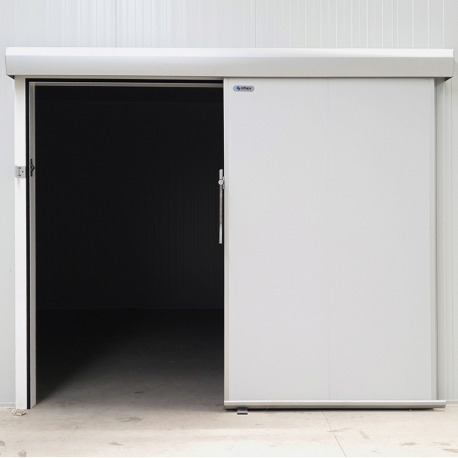002 Cold Room Sliding Door
The 002 Cold Room Sliding Door is a door for cold rooms (+0ºC) and freezing rooms (-20ºC). It has a hermetic closing system and is characterised by its lightness and versatility.
Cold doors can be equipped with the HTCP Infraca System to control the temperature of the heating elements, thus saving energy and costs.
Its installation is perfect for any type of cold room located in shops, production, shops, supermarkets, restaurants or hotels.
It includes a cover to avoid the generation of possible humidity.
The 002 Cold Room Sliding Door has optional features that allow the door to be personalised and corporatised, as well as having automation systems to facilitate contact-free opening or finishes that help to reinforce its hygienic quality, such as the steel sheet with a sanitary finish.
Features: 002 Cold Room Sliding Door
The 002 Cold Room Sliding Door is a door for cold rooms (+0ºC) and freezing rooms (-20ºC). It has a hermetic closing system and is characterised by its lightness and versatility.
Cold doors can be equipped with the HTCP Infraca System to control the temperature of the heating elements, thus saving energy and costs.
Colors: White (standard) or customised
Finishes: Lacquered steel, Stainless Steel AISI 304/2B, PVC, GRP,
Estructure: Self-supporting L-shaped extruded aluminum frame and counterframe with thermal break and double break in freezer doors.
Leaves: Individually injected, superimposed on the frame, with internal frame according to the thickness of the leaf and framed in anodized aluminum.
Sealing system: Hermetic seal. Double weatherstrip of high quality coextruded EDPM of variable density.
Automatism: Optional
Clear opening height: Max. 2.6m
Clear opening length: Max 2m
![]() New guide system with greater precision for regulation.
New guide system with greater precision for regulation.
![]() High flexibility co-extruded EDPM weather strip.
High flexibility co-extruded EDPM weather strip.
![]() Four-point precision adjustment.
Four-point precision adjustment.
![]() Low wear of mechanical elements.
Low wear of mechanical elements.
![]() Light and versatile door.
Light and versatile door.
![]() Self-supporting frame.
Self-supporting frame.
![]() Quick, easy and intuitive installation.
Quick, easy and intuitive installation.
![]() Pre-mounted doors.
Pre-mounted doors.
![]() High degree of sealing, insulation, and ease of adjustment to installation position.
High degree of sealing, insulation, and ease of adjustment to installation position.
![]() Corrosion resistance and reliability in aggressive environments
Corrosion resistance and reliability in aggressive environments
![]() Ease of maintenance.
Ease of maintenance.
![]() Does not require any auxiliary structure.
Does not require any auxiliary structure.





































